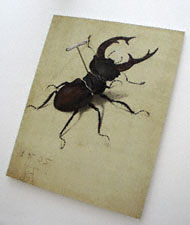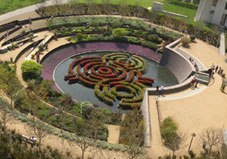Note: Words in bold below are defined in the glossary for this curriculum (see "For the Classroom" links).
Strictly speaking, the term "contemporary art" refers to art made and produced by artists living today. Today's artists work in and respond to a global environment that is culturally diverse, technologically advancing, and multifaceted. Working in a wide range of mediums, contemporary artists often reflect and comment on modern-day society. When engaging with contemporary art, viewers are challenged to set aside questions such as, "Is a work of art good?" or "Is the work aesthetically pleasing?" Instead, viewers consider whether art is "challenging" or "interesting." Contemporary artists may question traditional ideas of how art is defined, what constitutes art, and how art is made, while creating a dialogue with—and in some cases rejecting—the styles and movements that came before them.
Since the early 20th century, some artists have turned away from realistic representation and the depiction of the human figure, and have moved increasingly towards abstraction. In New York City after World War II, the art world coined the term "abstract expressionism" to characterize an art movement that was neither completely abstract, nor expressionistic. Nevertheless, the movement challenged artists to place more emphasis on the process of making art rather than the final product. Artists like Jackson Pollock brought art-making to choreographic heights by dripping paint in grand yet spontaneous gestures. As one critic noted, the canvas was an arena in which to act—"what was going on in the canvas was not a picture but an event." This notion of art as an event emerged out of the movement called abstract expressionism, which greatly influenced the art movements that followed, and continues to inspire artists living today.
Contemporary artists working within the postmodern movement reject the concept of mainstream art and embrace the notion of "artistic pluralism," the acceptance of a variety of artistic intentions and styles. Whether influenced by or grounded in performance art, pop art, Minimalism, conceptual art, or video, contemporary artists pull from an infinite variety of materials, sources, and styles to create art. For this reason, it is difficult to briefly summarize and accurately reflect the complexity of concepts and materials used by contemporary artists. This overview highlights a few of the contemporary artists whose work is on view at the Getty Museum and the concepts they explore in their work.
 |
||
Contemporary artists, like many artists that preceded them, may acknowledge and find inspiration in art works from previous time periods in both subject matter and formal elements. Sometimes this inspiration takes the form of appropriation. Artist John Baldessari "borrowed" an image from 1505 of a stag beetle by the German artist Albrecht Dürer and made it his own. Using modern-day materials (ink-jet printing mounted on a fiberglass panel), Baldessari juxtaposed the original image with a piece of sculpture in the form of a giant steel pin. By inserting the steel pin into the canvas, Baldessari combines mediums in a very modern way.
In the 1960s, artists began to turn to the medium of video to redefine fine art. Through video art, many artists have challenged preconceived notions of art as high priced, high-brow, and only decipherable by elite members of society. Video art is not necessarily a type of art that individuals would want to own, but rather an experience. Continuing the trend of redefining earlier ideas and ideals about art, some contemporary video artists are seeking to do away with the notion of art as a commodity. Artists turning to video have used the art form as a tool for change, a medium for ideas. Some video art openly acknowledges the power of the medium of television and the Internet, thus opening the doors of the art world to the masses.
 |
||
Such artists seek to elevate the process of creating art and move beyond the notion that art should only be valued as an aesthetically pleasing product. Video art exemplifies this, for the viewer watches the work as it is actually being made; they watch as the process unfolds. Video installation pieces combine video with sound, music, and/or other interactive components. In Nicole Cohen's Please Be Seated, viewers are asked to be active participants. Using innovative video technologies, participants can sit on replicas of 18th-century French chairs and watch television screens in which they are virtually inserted in historic recreations of 18th-century French spaces. While traditional works of art are in galleries with signs that say "Do not touch," Cohen invites you to physically participate. In this way, the viewer becomes part of the work of art.
 |
||
Robert Irwin is another artist who sought to involve the viewer, as seen in his garden at the Getty Center. In the Central Garden, which Irwin has playfully termed "a sculpture in the form of a garden aspiring to be art," viewers can experience a maze-like configuration of plants, stones, and water. Here visitors get completely immersed in the sensation of being within the work of art. The sense of smell, touch, and sound are juxtaposed with the colors and textures of the garden. All of the foliage and materials of the garden were selected to accentuate the interplay of light, color, and reflection. A statement by Irwin, "Always changing, never twice the same," is carved into the plaza floor, reminding visitors of the ever-changing nature of this living work of art. In this way, Irwin subverts the idea that a work of art should be paint on a canvas. Rather, nature can be art.
By creating a garden specifically designed for the Getty Center, Irwin engages in site-specific art. Many contemporary artists who create site-specific works move art out of museums and galleries and into communities to address socially significant issues and/or raise social consciousness. In the case of Irwin's garden and Martin Puryear's That Profile (also on view at the Getty Center), works of art are commissioned by museums to enhance and incorporate their surrounding environments. That Profile, stationed on the plaza at the foot of the stairs leading to the Museum, mimics the grid-like patterns of the Getty Center building itself. Weighing 7,500 pounds, That Profile is massive. However the work's graceful and curving lines have a "light and airy" quality that capitalizes on the surrounding mountains and ocean views visible from the Getty's plaza.
Questions such as "What is art?" and "What is the function of art?" are relatively new. Creating art that defies viewers' expectations and artistic conventions is a distinctly modern concept. However, artists of all eras are products of their relative cultures and time periods. Contemporary artists are in a position to express themselves and respond to social issues in a way that artists of the past were not able to. When experiencing contemporary art at the Getty Center, viewers use different criteria for judging works of art than criteria used in the past. Instead of asking, "Do I like how this looks?" viewers might ask, "Do I like the idea this artist presents?" Having an open mind goes a long way towards understanding, and even appreciating, the art of our own era.